Thiết lập tính siêu ổn định của phương trình hàm tuyến tính suy rộng nhiều biến trong không gian tựa chuẩn
Trong bài báo này, chúng tôi thiết lập và chứng minh tính siêu ổn định của phương trình hàm
tuyến tính suy rộng nhiều biến trong không gian tựa chuẩn. Đồng thời, sử dụng kết quả đạt được,
chúng tôi suy ra một số kết quả đã có và một số trường hợp đặc biệt của lớp phương trình hàm tuyến
tính suy rộng nhiều biến.
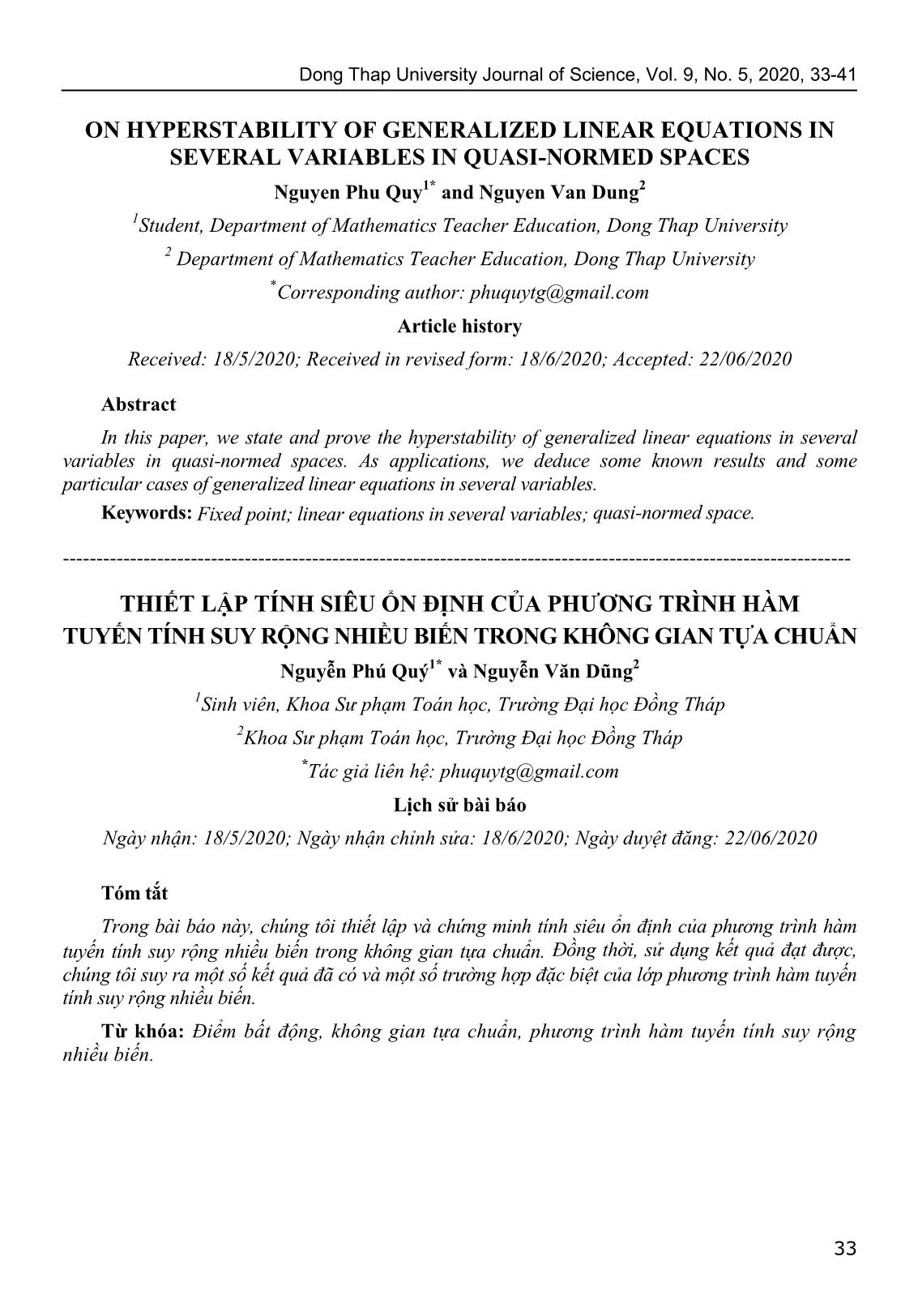
Trang 1
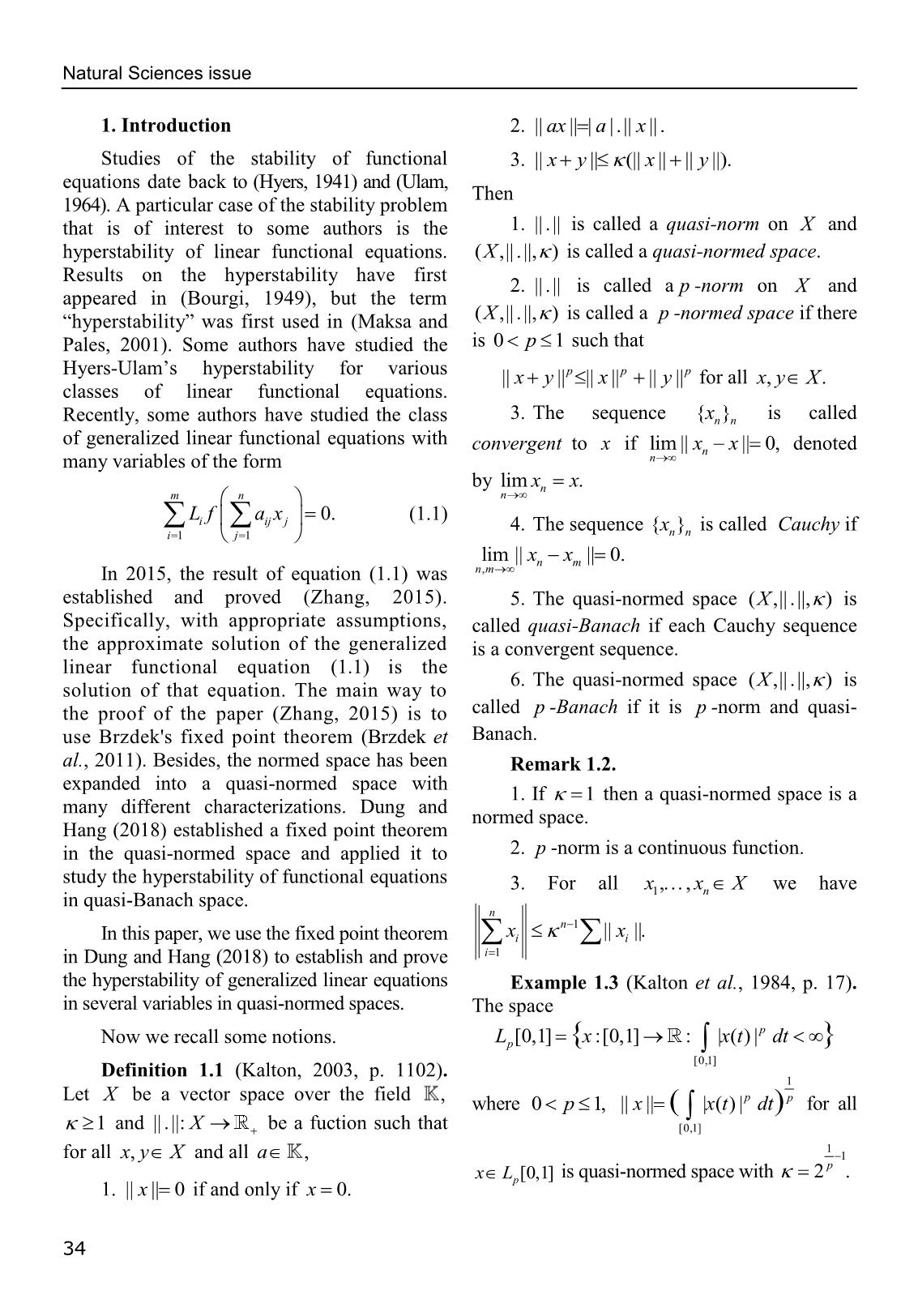
Trang 2
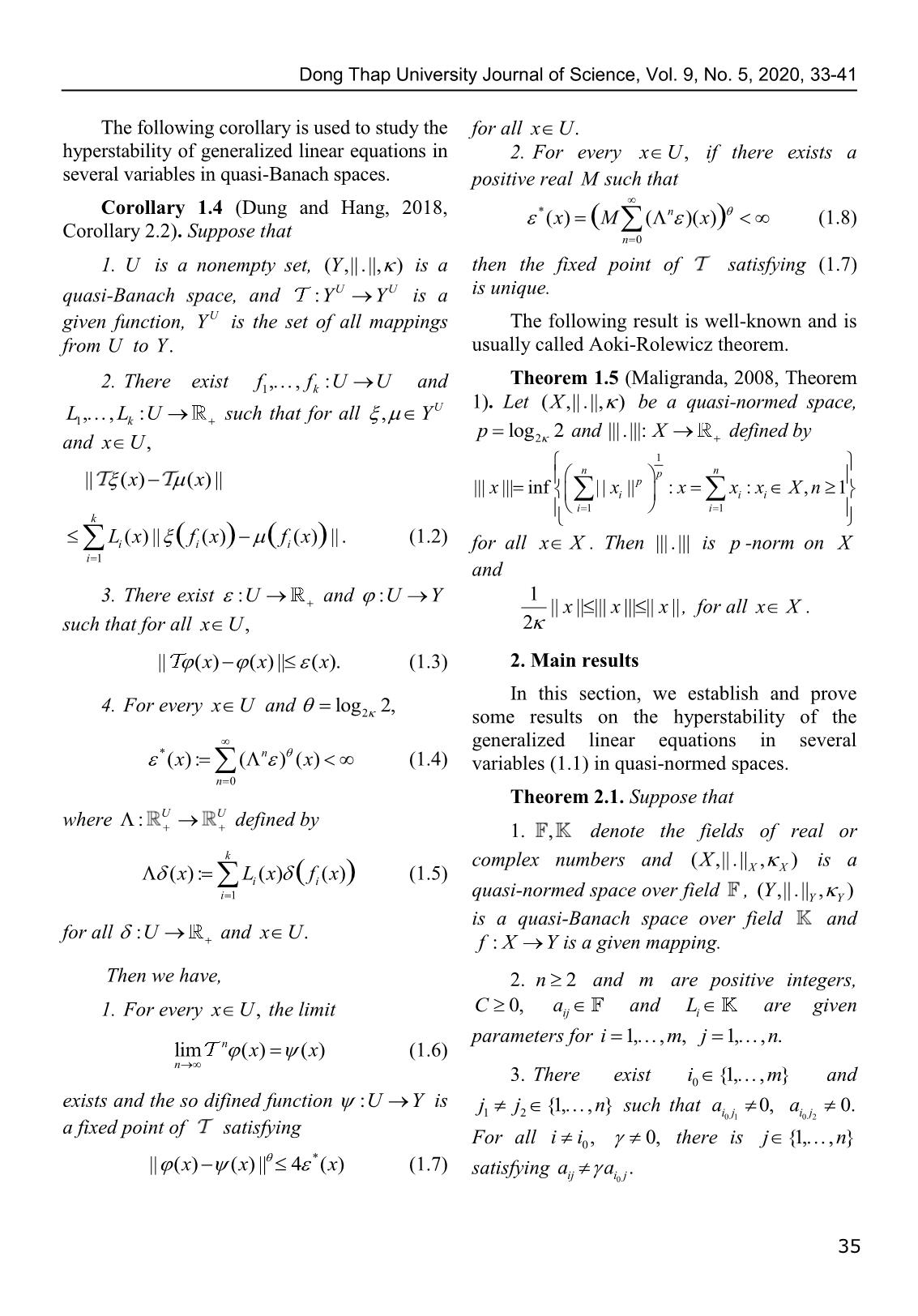
Trang 3
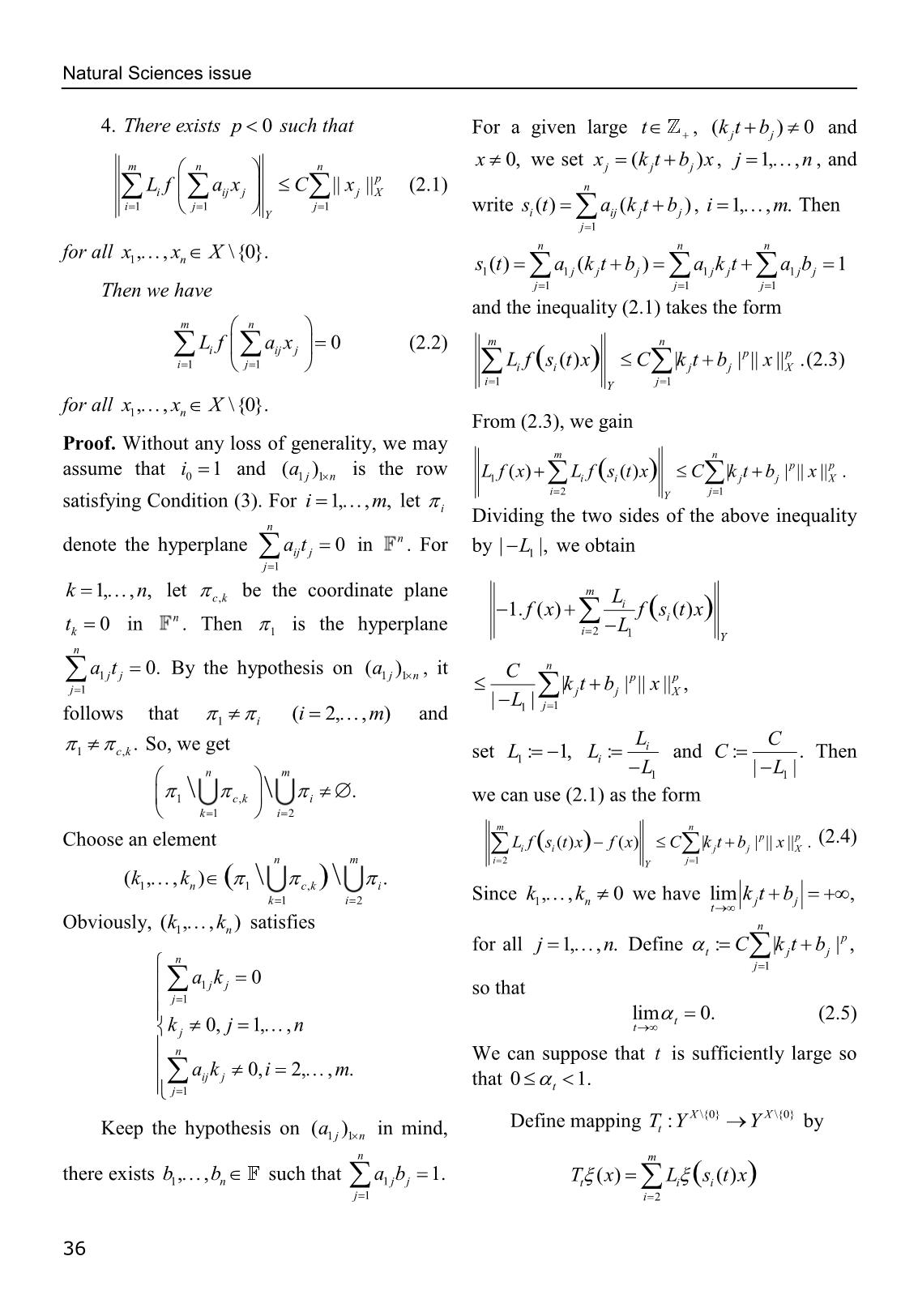
Trang 4

Trang 5

Trang 6
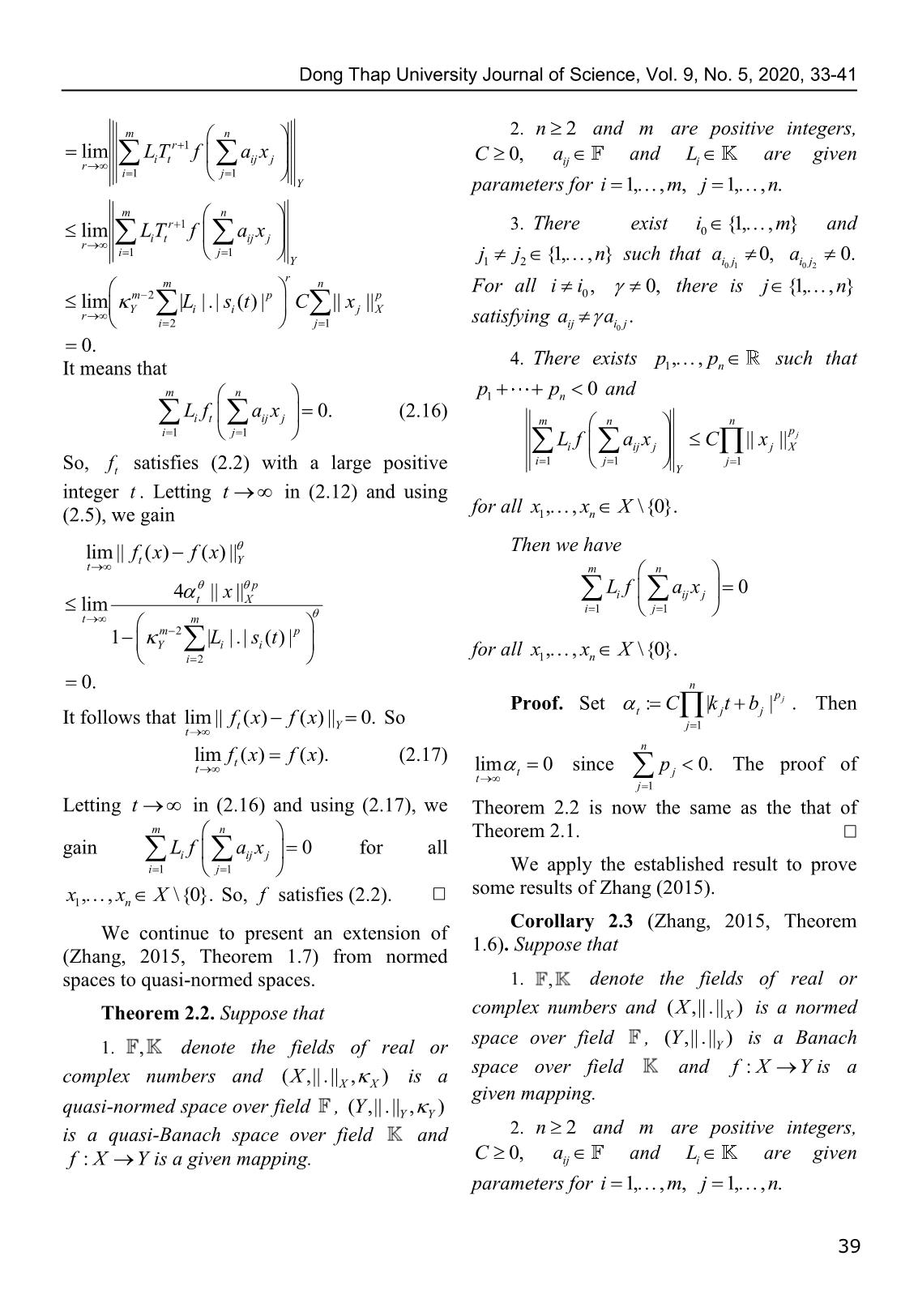
Trang 7
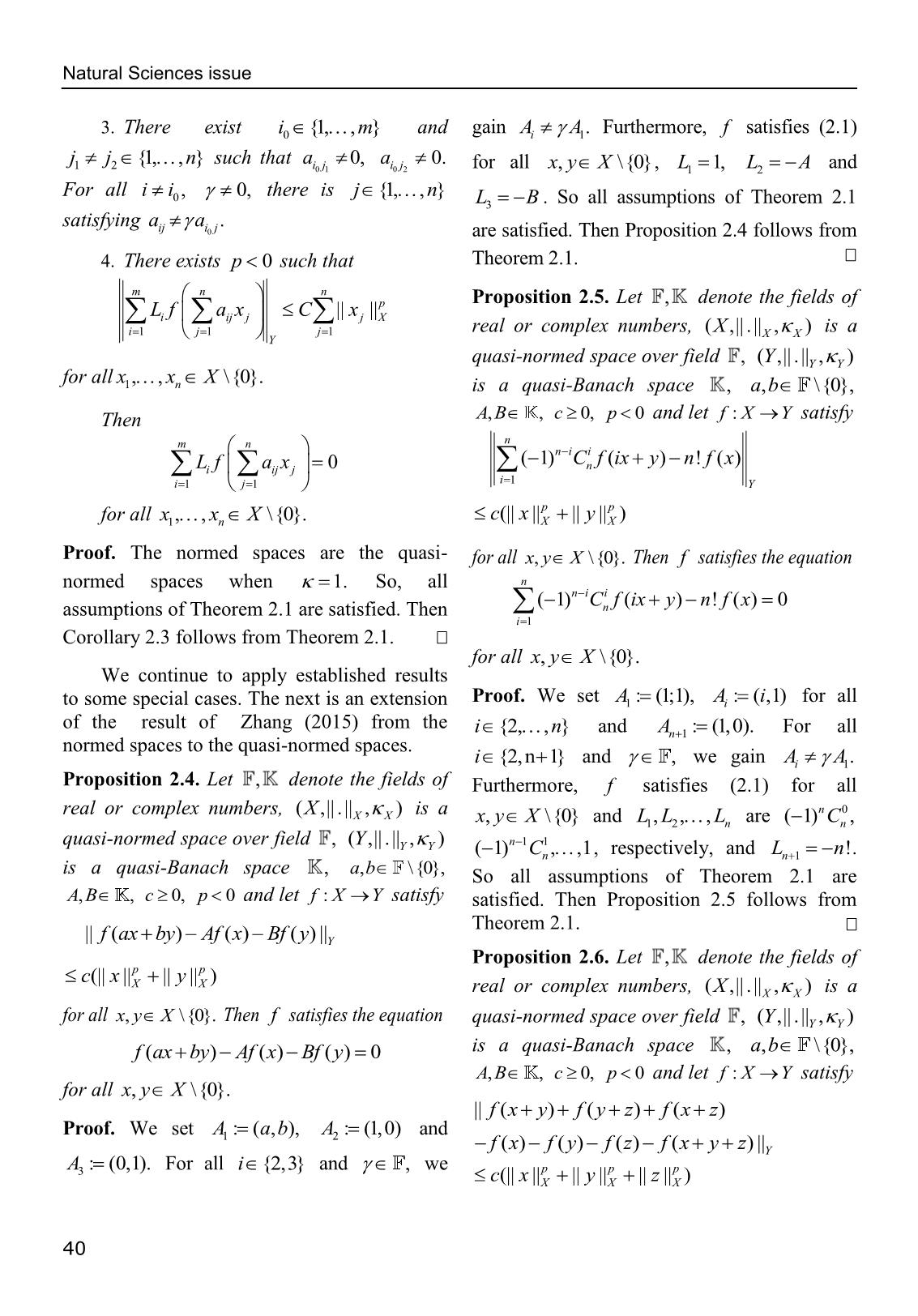
Trang 8
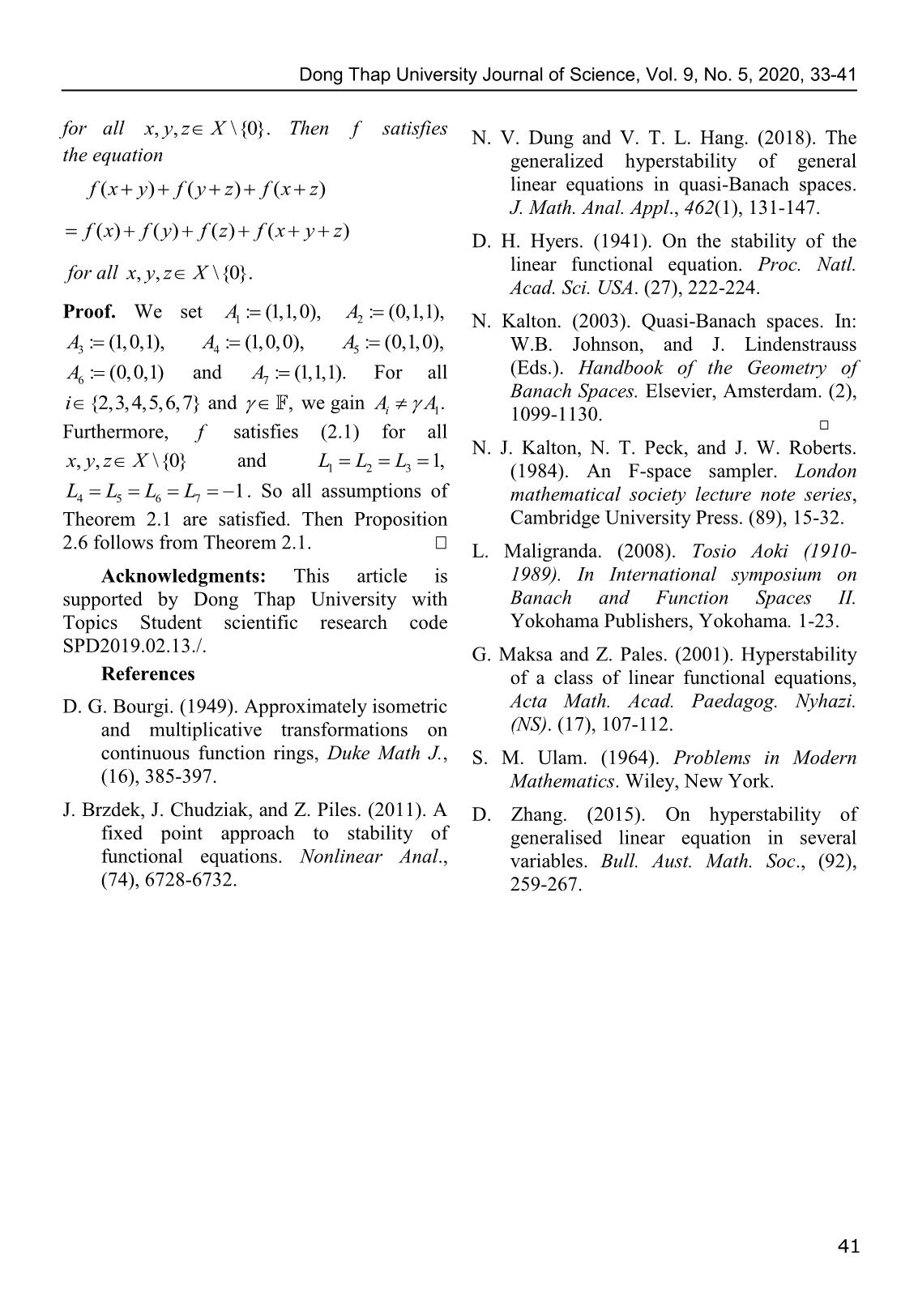
Trang 9
Bạn đang xem tài liệu "Thiết lập tính siêu ổn định của phương trình hàm tuyến tính suy rộng nhiều biến trong không gian tựa chuẩn", để tải tài liệu gốc về máy hãy click vào nút Download ở trên
Tóm tắt nội dung tài liệu: Thiết lập tính siêu ổn định của phương trình hàm tuyến tính suy rộng nhiều biến trong không gian tựa chuẩn

l a , 1
xL [0,1] is quasi-normed space with 2 p .
1. ||x || 0 if and only if x 0. p
34
Dong Thap University Journal of Science, Vol. 9, No. 5, 2020, 33-41
The following corollary is used to study the for all xU .
hyperstability of generalized linear equations in 2. For every xU , if there exists a
several variables in quasi-Banach spaces. positive real M such that
Corollary 1.4 (Dung and Hang, 2018, * (x ) () M ( n )( x ) (1.8)
Corollary 2.2). Suppose that n 0
1. U is a nonempty set, (Y ,||.||, ) is a then the fixed point of satisfying (1.7)
quasi-Banach space, and :YYUU is a is unique.
given function, Y U is the set of all mappings The following result is well-known and is
from U to Y. usually called Aoki-Rolewicz theorem.
Theorem 1.5 (Maligranda, 2008, Theorem
2. There exist f1,,: fk U U and
1). Let (X ,||.||, ) be a quasi-normed space,
LLU,,: such that for all , Y U
1 k p log 2 and |||.|||: X defined by
and xU , 2
1
nnp
|| (xx ) ( ) || p
|||x ||| inf || xi || : x x i : x i X , n 1
ii 11
k
Li( x ) ||()() f i ( x ) f i ( x ) ||. (1.2) for all xX . Then |||.||| is p -norm on X
i 1
and
3. There exist :U and :UY 1
||xxx || ||| ||| || ||, for all xX .
such that for all xU , 2
|| ()x ()|| x (). x (1.3) 2. Main results
In this section, we establish and prove
4. For every xU and log 2,
2 some results on the hyperstability of the
generalized linear equations in several
* n
():()()xx (1.4) variables (1.1) in quasi-normed spaces.
n 0
Theorem 2.1. Suppose that
where : UU defined by
1. , denote the fields of real or
k
complex numbers and (X ,||.||XX , ) is a
():()()x Lii x() f x (1.5)
i 1 quasi-normed space over field , (Y ,||.||YY , )
is a quasi-Banach space over field and
for all :U and xU .
f: X Y is a given mapping.
Then we have, 2. n 2 and m are positive integers,
1. For every xU , the limit C 0, aij and Li are given
parameters for im 1, , , jn 1, , .
limn (xx ) ( ) (1.6)
n
3. There exist im0 {1, , } and
exists and the so difined function :UY is j j {1, , n } such that a 0, a 0.
12 ij01 ij02
a fixed point of satisfying
For all ii 0 , 0, there is jn {1, , }
*
||() x ()|| x 4 () x (1.7) satisfying aa .
ij i0 j
35
Natural Sciences issue
4. There exists p 0 such that For a given large t , (kjj t b ) 0 and
m n n x 0, we set xj () k j t b j x , jn 1, , , and
p
Li f a ij x j C || x j || X (2.1) n
i 1 j 1 j 1 write s()() t a k t b , im 1, , . Then
Y i ij j j
j 1
n n n
for all x1, , xn X \{0}.
st1( ) aktb 1j ( j j ) akt 1 j j ab 1 j j 1
Then we have j 1 j 1 j 1
and the inequality (2.1) takes the form
mn
L f a x 0 (2.2) mn
i ij j pp
ij 11 Li f() s i() t x C| k j t b j | || x || X .(2.3)
ij 11Y
for all x, , x X \{0}.
1 n From (2.3), we gain
Proof. Without any loss of generality, we may
mn
assume that i 1 and ()a is the row pp
0 11jn Lfx1 ( ) Lfstxi() i ( ) C | ktb j j | || x || X .
satisfying Condition (3). For im 1, , , let ij 21Y
i Dividing the two sides of the above inequality
n
n
denote the hyperplane atij j 0 in . For by | L1 |, we obtain
j 1
m
kn 1, , , let ck, be the coordinate plane
Li
1.f ( x ) f() si ( t ) x
t 0 in . Then is the hyperplane i 2 L
k 1 1 Y
n
n
at1 jj 0. By the hypothesis on ()a11jn , it C pp
j 1 |kj t b j | || x || X ,
|| L1 j 1
follows that 1 i (im 2, , ) and
L C
1, ck. So, we get set L : 1, L : i and C :. Then
1 i L || L
nm 1 1
1,\\ c k i . we can use (2.1) as the form
ki 12
mn
Choose an element pp (2.4)
Lfstxi() i() fx( ) C | ktb j j | || x || X .
nm ij 21Y
(,,).kk1 n(\)\ 1 c , k i
ki 12 Since kk1, ,n 0 we have limkjj t b ,
t
Obviously, (,,)kk1 n satisfies n
p
for all jn 1, , . Define t: C | k j t b j | ,
n
j 1
ak 0
1 jj so that
j 1
lim t 0. (2.5)
kj 0, j 1, , n t
n We can suppose that t is sufficiently large so
a k 0, i 2, , m .
ij j that 0 1.
j 1 t
XX\{0} \{0}
Define mapping TYYt : by
Keep the hypothesis on ()a11jn in mind,
n m
there exists bb,, such that ab 1.
1 n 1 jj Tt()() x L i() s i t x
j 1 i 2
36
Dong Thap University Journal of Science, Vol. 9, No. 5, 2020, 33-41
X \{0} n
for all xX \{0} and Y . We set m
n m 2 p p (2.8)
t t(x ) Y | L i |.| s i ( t ) | t || x || X .
p i 2
t(xx ) t || || X (2.6)
Indeed, if n 0 , then (2.8) holds by (2.6).
for all xX \{0}. The inequality (2.4) can be Suppose that (2.8) holds for nk , that is,
k
written as m
k(x ) m 2 | L |.| s ( t ) | p || x || p .
||T f () x f ()|| x (). x t t Y i i t X
t Y t i 2
This proves that (1.3) is satisfied. We have
XX\{0} \{0}
k 1
Define mapping t : by
tt ()x
m
(x ) m 2 | L | s ( t ) x (2.7) k
t Y i() i t() t t ()x
i 2
k
X \{0} mm
m 22 m p p
for all xX \{0} and . This proves
Y|L i | Y | L i |.| s i ( t ) | t || s i ( t ) x || X
ii 22
that (2.7) has the form as (1.5), where Li is
mmk
replaced by m 2 |L |. Furthermore, for all m 22 p m p p
Yi Y|L i |.| s i ( t ) | . Y | L i |.| s i ( t ) | t || x || X
ii 22
, Y X \{0} , xX \{0} and Remark 1.2 (3),
m k 1
we have m 2 p p
Y|L i |.| s i ( t ) | t || x || X .
i 2
||Tt ( x ) T t ( x ) || Y
So, (2.8) holds for all n .
mm
L s()() t x L s t x By using (2.8) with log 2, we gain
i()() i i i 2Y
ii 22Y *
t ()x
m
()()n x
[Li ( s i()() t x ) L i ( s i t x )] tt
i 2 Y n 0
n
m
m m 2 |L |.| s ( t ) | p || x || p . (2.9)
m 2 |L |.|| s ( t ) x s ( t ) x || . Y i i t X
Y i()() i i Y ni 02
i 2
n n n
It proves that (1.2) is satisfied when is sti()() aktb ijj j akt ijj ab ijj and
j 1 j 1 j 1
replaced by n
akij j 0 for all im 2, , , we have
For all xX \{0} we have j 1
nn
tt ()x
lim |si ( t ) | lim a ij k j t a ij b j .
m tt
jj 11
mp 2 |L |. || s ( t ) x ||
Y i t i X m
i 2 mp 2
So, we gain limY |L i |.| s i ( t ) | 0. We
m t
m 2 p p i 2
Y|L i |.| s i ( t ) | t || x || X .
i 2 choose a large positive integer t such that
m
By induction, we will show that for all mp 2
Y|L i |.| s i ( t ) | 1. (2.10)
xX \{0}, n i 2
Then
37
Natural Sciences issue
n
m mn
mp 2 |L |.| s ( t ) | l
Y i i LTi t f a ij x j
ni 02 ij 11
Y
1 mnl
(2.11) m 2 p p
m |L |.| s ( t ) | C || x || .
mp 2 Yii j X
1 Y |L i |.| s i ( t ) | i 21j
i 2
We have
mn
By using (2.9) and (2.11), we have l 1
LTi t f() a ij x j
p ij 11
Y
* tX||x ||
t ()x
m mm n
l
mp 2 L L T f() s() t a x
1 Y |L i |.| s i ( t ) | i k t k ij j
i 1 k 2 j 1
i 2 Y
m m n
for all xX \{0}. This proves that (1.4) l
Lk LT i t f() a ij s k() t x j
k 2 i 1 j 1
is satisfied. Y
According to Corollary 1.4, with a large m m n
m 2 |L | LTl f a s ( t ) x
positive integer t , there exists a fixed point Y k i t() ij k j
k 2 i 1 j 1
Y
ft : X Y of Tt f t()() x f t x satisfying
m ml n
m 22 m p p
||ftY ( x ) f ( x ) || Y|L k | Y | L i |.| s i ( t ) | C || s k ( t ) x j || X
ki 2 2j 1
*
4 (x ) l
t mm
m 22|L |.| s ()| t p . m ||.|()| L s t p
4 ||x || p Y k k Y i i
tX (2.12) ki 22
m n
mp 2 p
1 Y |L i |.| s i ( t ) | .Cx||jX ||
i 2 j 1
mnl 1
for all xX \{0}. Furthermore, by (1.6) m 2 p p
Y|L i |.| s i ( t ) | C || x j || X .
we obtain ij 21
n
ftt( x ) lim T f ( x ). (2.13)
n So, (2.14) holds for all r .
By using (2.10), we gain
By induction, we will show that for all
mnr
xX \{0}, r m 2 p p
limY |L i |.| s i ( t ) | C || x j || X 0. (2.15)
r
ij 21
mn
r From (2.13), (2.14), (2.15), Remark 1.2 (2) and
LTi t f a ij x j
ij 11 Theorem 1.5, we obtain
Y
mn
mnr
m 2 p p
Li f t a ij x j
Y|L i |.| s i ( t ) | C || x j || X . (2.14)
ij 11
ij 21 Y
mn
Indeed, if r 0 , then (2.14) holds by (2.1). r 1
lim LTi t f a ij x j
Suppose that (2.14) holds for rl , that is, r
ij 11
Y
38
Dong Thap University Journal of Science, Vol. 9, No. 5, 2020, 33-41
mn 2. n 2 and m are positive integers,
r 1
lim LTi t f a ij x j C 0, a and L are given
r ij i
ij 11
Y parameters for im 1, , , jn 1, , .
mn
r 1
3. There exist im0 {1, , } and
lim LTi t f a ij x j
r
ij 11 j j {1, , n } such that a 0, a 0.
Y 12 ij01 ij02
mnr
m 2 p p For all ii 0 , 0, there is jn {1, , }
lim Y |L i |.| s i ( t ) | C || x j || X
r satisfying aa .
ij 21 ij i0 j
0.
4. There exists pp,, such that
It means that 1 n
mn pp1 n 0 and
Li f t a ij x j 0. (2.16)
mn n
ij 11 p j
Li f a ij x j C|| x j || X
ij 11 j 1
So, ft satisfies (2.2) with a large positive Y
integer t . Letting t in (2.12) and using
for all x, , x X \{0}.
(2.5), we gain 1 n
Then we have
lim ||ftY ( x ) f ( x ) ||
t mn
p L f a x 0
4 tX ||x || i ij j
lim ij 11
t m
1 mp 2 |L |.| s ( t ) |
Y i i for all x, , x X \{0}.
i 2 1 n
0. n
p j
Proof. Set t:| C k j t b j | . Then
It follows that lim ||ftY ( x ) f ( x ) || 0. So j 1
t
n
limft ( x ) f ( x ). (2.17)
t lim t 0 since p j 0. The proof of
t
j 1
Letting t in (2.16) and using (2.17), we Theorem 2.2 is now the same as the that of
mn Theorem 2.1.
gain Li f a ij x j 0 for all
ij 11 We apply the established result to prove
some results of Zhang (2015).
x1, , xn X \{0}. So, f satisfies (2.2).
Corollary 2.3 (Zhang, 2015, Theorem
We continue to present an extension of
1.6). Suppose that
(Zhang, 2015, Theorem 1.7) from normed
spaces to quasi-normed spaces. 1. denote the fields of real or
Theorem 2.2. Suppose that complex numbers and (X ,||.||X ) is a normed
space over field , (Y ,||.|| ) is a Banach
1. , denote the fields of real or Y
complex numbers and (X ,||.|| , ) is a space over field and f: X Y is a
XX given mapping.
quasi-normed space over field , (Y ,||.||YY , )
is a quasi-Banach space over field and 2. and are positive integers,
f: X Y is a given mapping. and are given
parameters for
39
Natural Sciences issue
3. There exist im0 {1, , } and gain AAi 1. Furthermore, f satisfies (2.1)
j j {1, , n } such that a 0, a 0.
12 ij01 ij02 for all x, y X \{0}, L1 1, LA2 and
For all ii 0 , 0, there is jn {1, , }
LB3 . So all assumptions of Theorem 2.1
satisfying aa .
ij i0 j are satisfied. Then Proposition 2.4 follows from
4. There exists p 0 such that Theorem 2.1.
m n n
p Proposition 2.5. Let denote the fields of
Li f a ij x j C || x j || X
i 1 j 1 j 1 real or complex numbers, is a
Y
quasi-normed space over field
for all x1, , xn X \{0}. is a quasi-Banach space ab, \{0},
Then and let satisfy
mn n
n i i
( 1)C f ( ix y ) n ! f ( x )
Li f a ij x j 0 n
ij 11 i 1 Y
pp
for all x1, , xn X \{0}. c(|| x ||XX || y || )
Proof. The normed spaces are the quasi- for all Then satisfies the equation
normed spaces when 1. So, all n
( 1)n iC i f ( ix y ) n ! f ( x ) 0
assumptions of Theorem 2.1 are satisfied. Then n
i 1
Corollary 2.3 follows from Theorem 2.1.
for all x, y X \{0}.
We continue to apply established results
to some special cases. The next is an extension Proof. We set A1 : (1;1), Aii : ( ,1) for all
of the result of Zhang (2015) from the
in {2, , } and An 1 : (1,0). For all
normed spaces to the quasi-normed spaces.
i {2,n 1} and , we gain AAi 1.
Proposition 2.4. Let , denote the fields of Furthermore, f satisfies (2.1) for all
n 0
real or complex numbers, (X ,||.||XX , ) is a
x, y X \{0} and LLL12,,, n are ( 1) Cn ,
quasi-normed space over field , (Y ,||.||YY , ) n 11
( 1)Cn , ,1, respectively, and Lnn 1 !.
is a quasi-Banach space , ab, \{0}, So all assumptions of Theorem 2.1 are
AB,, c 0, p 0 and let f: X Y satisfy satisfied. Then Proposition 2.5 follows from
Theorem 2.1.
||f ( ax by ) Af ( x ) Bf ( y ) ||Y
Proposition 2.6. Let denote the fields of
c(|| x ||pp || y || )
XX real or complex numbers, is a
for all x, y X \{0}. Then f satisfies the equation quasi-normed space over field
f( ax by ) Af ( x ) Bf ( y ) 0 is a quasi-Banach space
and let satisfy
for all x, y X \{0}.
||f ( x y ) f ( y z ) f ( x z )
Proof. We set A1 : ( a , b ), A2 : (1,0) and
f( x ) f ( y ) f ( z ) f ( x y z ) ||Y
A3 : (0,1). For all i {2,3} and , we p p p
c(|| x ||XXX || y || || z || )
40
Dong Thap University Journal of Science, Vol. 9, No. 5, 2020, 33-41
for all x, y , z X \{0}. Then f satisfies N. V. Dung and V. T. L. Hang. (2018). The
the equation generalized hyperstability of general
f()()() x y f y z f x z linear equations in quasi-Banach spaces.
J. Math. Anal. Appl., 462(1), 131-147.
f()()()() x f y f z f x y z
D. H. Hyers. (1941). On the stability of the
for all x, y , z X \{0}. linear functional equation. Proc. Natl.
Acad. Sci. USA. (27), 222-224.
Proof. We set A : (1,1,0), A : (0,1,1),
1 2 N. Kalton. (2003). Quasi-Banach spaces. In:
A3 : (1,0,1), A4 : (1,0,0), A5 : (0,1,0), W.B. Johnson, and J. Lindenstrauss
(Eds.). Handbook of the Geometry of
A6 : (0,0,1) and A7 : (1,1,1). For all
Banach Spaces. Elsevier, Amsterdam. (2),
i {2,3,4,5,6,7} and , we gain AA .
i 1 1099-1130.
Furthermore, f satisfies (2.1) for all
N. J. Kalton, N. T. Peck, and J. W. Roberts.
x, y , z X \{0} and LLL 1,
1 2 3 (1984). An F-space sampler. London
LLLL4 5 6 7 1. So all assumptions of mathematical society lecture note series,
Theorem 2.1 are satisfied. Then Proposition Cambridge University Press. (89), 15-32.
2.6 follows from Theorem 2.1. L. Maligranda. (2008). Tosio Aoki (1910-
Acknowledgments: This article is 1989). In International symposium on
supported by Dong Thap University with Banach and Function Spaces II.
Topics Student scientific research code Yokohama Publishers, Yokohama. 1-23.
SPD2019.02.13./. G. Maksa and Z. Pales. (2001). Hyperstability
References of a class of linear functional equations,
D. G. Bourgi. (1949). Approximately isometric Acta Math. Acad. Paedagog. Nyhazi.
and multiplicative transformations on (NS). (17), 107-112.
continuous function rings, Duke Math J., S. M. Ulam. (1964). Problems in Modern
(16), 385-397. Mathematics. Wiley, New York.
J. Brzdek, J. Chudziak, and Z. Piles. (2011). A D. Zhang. (2015). On hyperstability of
fixed point approach to stability of generalised linear equation in several
functional equations. Nonlinear Anal., variables. Bull. Aust. Math. Soc., (92),
(74), 6728-6732. 259-267.
41 File đính kèm:
 thiet_lap_tinh_sieu_on_dinh_cua_phuong_trinh_ham_tuyen_tinh.pdf
thiet_lap_tinh_sieu_on_dinh_cua_phuong_trinh_ham_tuyen_tinh.pdf

